Ensuring proper dental care for your dog is a fundamental aspect of responsible pet ownership. Brushing your dog's teeth regularly is not only beneficial for their oral health but also plays a crucial role in their overall well-being.
As a pet owner, understanding the correct techniques for brushing your dog's teeth at home can be the key to preventing dental issues and maintaining a healthy lifestyle for your furry friend. Stay tuned to discover essential tips from a veterinarian on how to effectively brush your dog's teeth and establish a successful dental care routine.
Key Takeaways
- Choose pet-friendly toothpaste with safe ingredients and appealing flavors.
- Select a suitable toothbrush and use gentle, circular motions for effective cleaning.
- Ensure proper technique by focusing on visible surfaces and the gum line.
- Start slow, keep sessions short, and provide positive reinforcement for a positive brushing experience.
Importance of Brushing Your Dog's Teeth
Regular brushing of your dog's teeth is crucial for maintaining their overall health and well-being. It is a key aspect of preventative care that can help prevent harmful diseases, extend your dog's life, and save money on potential dental treatments in the long run.
Just like humans, dogs require regular dental care to ensure strong and healthy teeth. By incorporating brushing into your dog's routine, you are taking a proactive step towards their oral hygiene.
Consistent brushing can also help in preventing plaque buildup, tartar accumulation, and other dental issues that could impact your dog's quality of life. Make brushing a priority to safeguard your furry friend's dental health and overall well-being.
Benefits of Using Pet-Friendly Toothpaste
In addition to the importance of regular dental care for your dog, utilizing pet-friendly toothpaste offers numerous benefits that contribute to their overall oral health and well-being.
Pet-friendly toothpaste is specially formulated with safe ingredients that are suitable for your dog's digestive system, as opposed to human toothpaste, which can be harmful if ingested. These toothpaste options often come in appealing flavors like beef or chicken, making the brushing experience more enjoyable for your furry friend.
Choosing the Right Toothpaste Flavors
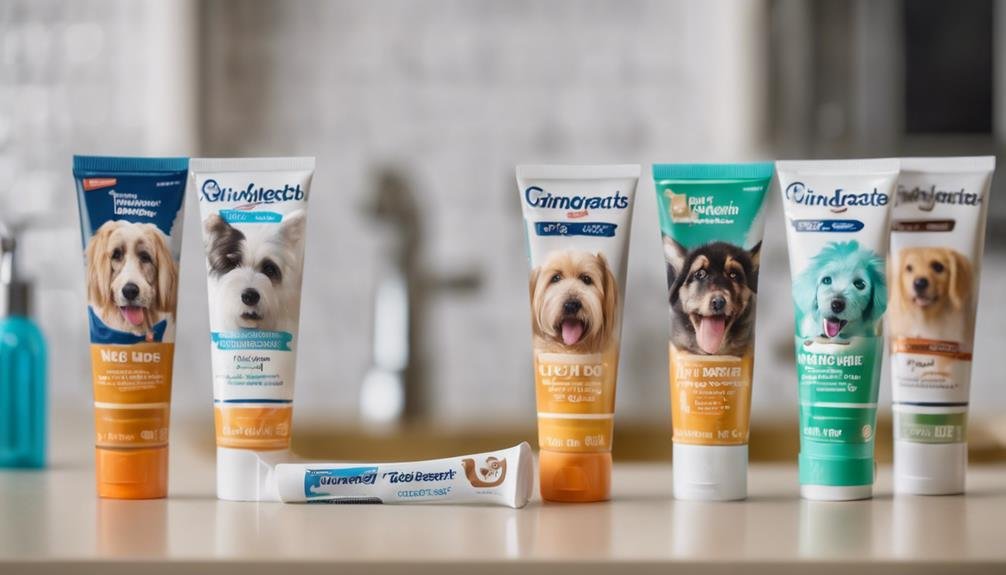
When selecting toothpaste flavors for your dog, opt for options such as beef or chicken to enhance the brushing experience and promote oral hygiene. Choosing the right flavor can make the brushing process more enjoyable for both you and your furry friend. Here are some tips to consider when selecting toothpaste flavors:
- Consider Your Dog's Preferences: Some dogs may have specific flavor preferences, so choose a toothpaste that appeals to your dog's taste buds.
- Avoid Artificial Ingredients: Opt for toothpaste flavors that are free from artificial colors or additives to ensure your dog's safety.
- Consult Your Vet: If your dog has specific dental needs or allergies, consult your vet to determine the most suitable toothpaste flavor.
- Rotate Flavors: To keep things interesting, consider rotating between different flavors to prevent your dog from getting bored with the same taste.
Selecting the Proper Toothbrush Size
Selecting the right toothbrush size for your dog is crucial in ensuring effective oral hygiene maintenance. When choosing a toothbrush, opt for a children's toothbrush with small bristles that can easily fit into your dog's mouth.
Alternatively, consider using a finger brush that can reach the nooks and crannies of your dog's teeth. It's essential to find a brush that works well with your dog's mouth size to ensure thorough cleaning.
Different brush options are available, so select one that is comfortable for both you and your furry friend. The design of the toothbrush should facilitate gentle cleaning to prevent any irritation to your dog's teeth and gums.
Options for Brushing Technique
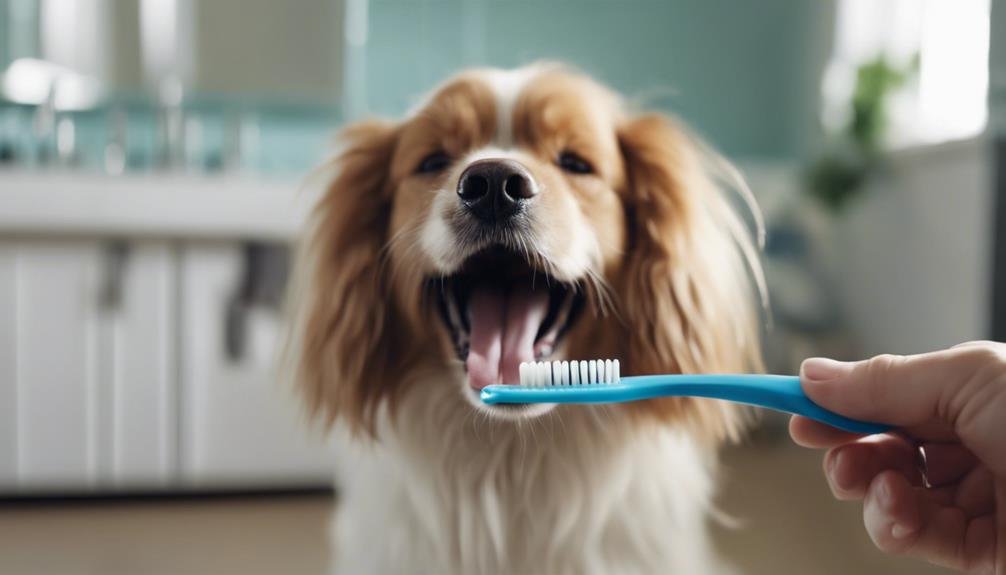
To ensure effective maintenance of your dog's oral hygiene, it is essential to explore various techniques for brushing their teeth with care and precision. Here are some options for brushing technique:
- Vertical Brushing: Start by gently brushing in an up and down motion to clean the front and back of the teeth thoroughly.
- Circular Motion: Use small circular motions to scrub the teeth and gums, ensuring all surfaces are cleaned.
- Focus on Gum Line: Pay close attention to the gum line, as it is a common area for bacteria buildup that can lead to gum disease.
- Gradual Progression: Introduce brushing gradually over several weeks, allowing your dog to get accustomed to the process while ensuring a positive experience.
Ensuring Your Dog's Comfort
Ensuring your dog's comfort during the teeth-brushing process is paramount to establishing a positive oral hygiene routine for your furry companion. To achieve this, create a calming environment, use gentle motions, and offer praise and treats for cooperation.
Begin by making the experience positive and rewarding for your dog. Choose a quiet, well-lit area for brushing and maintain a relaxed demeanor to reassure your pet. Approach the process with patience, allowing your dog to become accustomed to the sensation of having their teeth brushed.
It is essential to prioritize your dog's comfort to build trust and ensure a successful brushing routine in the long term.
Getting Your Dog Used to Brushing
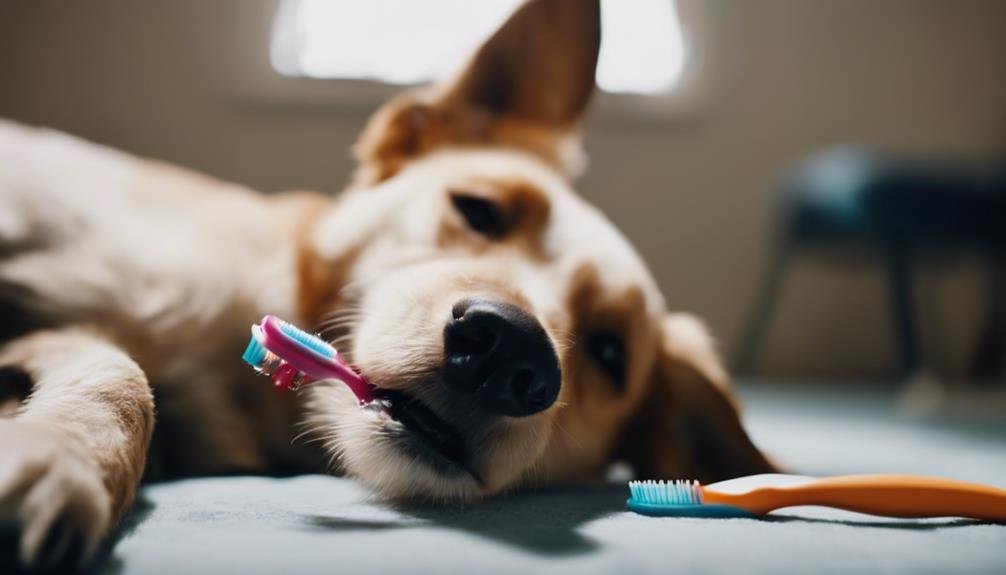
To establish a successful teeth-brushing routine for your dog, acclimating them to the process is crucial for their oral hygiene care. Here are some tips to help your dog get used to brushing:
- Start Slow: Introduce the toothbrush gradually, allowing your dog to sniff and lick it before attempting to brush.
- Use Positive Reinforcement: Reward your dog with treats or praise after each brushing session to create a positive association.
- Short Sessions: Begin with short brushing sessions and gradually increase the time as your dog becomes more comfortable.
- Consistency is Key: Aim to brush your dog's teeth at the same time each day to establish a routine they can expect and become accustomed to.
Patience During the Brushing Process
Maintaining a calm and patient demeanor is paramount when brushing your dog's teeth to ensure a positive and effective oral care routine. Dogs may initially resist teeth brushing due to the unfamiliar sensation, so it's crucial to approach the process with patience.
Rushing or showing signs of frustration can lead to a negative experience for your dog, making future brushing sessions more challenging. Remember, your dog is learning a new routine, and it may take time for them to become comfortable with the process.
Gradual Introduction of Brushing
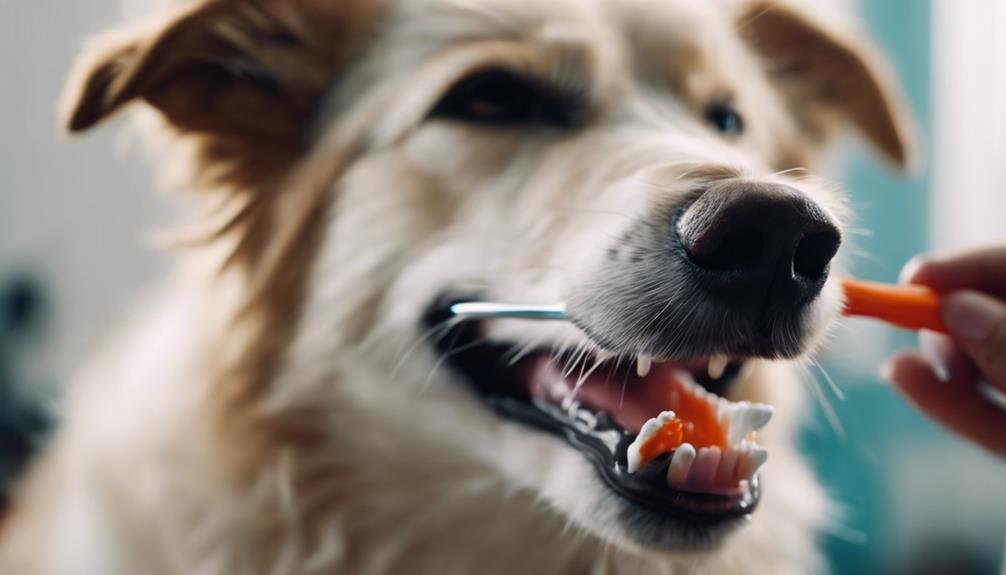
Implementing a gradual approach when introducing teeth brushing to your dog is crucial for their comfort and long-term acceptance of this essential oral care routine. To ensure a smooth transition, consider the following steps:
- Familiarization: Start by allowing your dog to sniff and lick the toothbrush and toothpaste to get accustomed to the new items.
- Touching Practice: Gently touch your dog's mouth and teeth with your finger to introduce the sensation of brushing.
- Short Sessions: Begin with short brushing sessions, gradually increasing the duration as your dog becomes more comfortable.
- Positive Reinforcement: Reward your dog with treats, praise, or playtime after each brushing session to create a positive association with the activity.
Techniques for Effective Brushing
Effective brushing of your dog's teeth involves utilizing gentle circular motions to ensure thorough cleaning without causing irritation. Start by brushing the visible teeth, then progress to the gum line to prevent bacteria buildup. Use small, round circles to scrub the teeth, focusing on each tooth individually.
It's crucial to be gentle to avoid irritating the sensitive gums and teeth. Brush gradually over several weeks, allowing your dog to become accustomed to the process. Pay attention to any signs of discomfort and adjust your technique accordingly.
Consistency is key in maintaining your dog's oral health, so make brushing a regular part of your pet care routine.
Starting With Visible Teeth
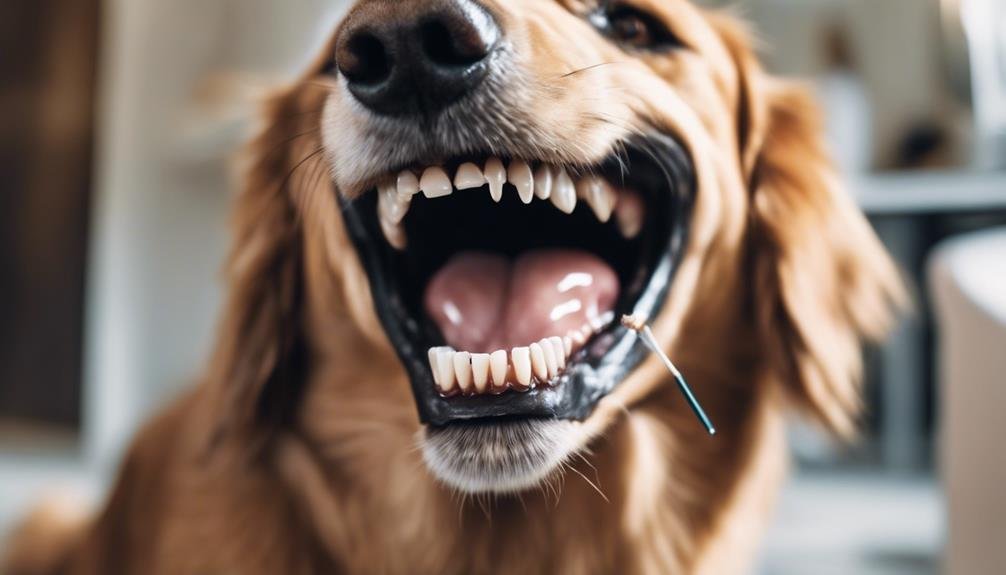
To ensure a thorough cleaning process and prevent bacteria buildup, it is essential to begin the teeth brushing routine by focusing on the visible teeth of your dog. This step allows for a targeted approach to cleaning the most accessible areas before progressing to more intricate parts of the mouth.
Here are four key points to consider when starting with visible teeth:
- Inspect Teeth: Start by visually examining your dog's teeth to identify any visible plaque or tartar buildup.
- Lift Lips: Gently lift your dog's lips to expose the front teeth and ensure all visible surfaces are adequately cleaned.
- Use Proper Lighting: Adequate lighting can help you spot any areas that require more attention during brushing.
- Maintain Patience: Approach the process calmly and patiently to help your dog become comfortable with this initial step.
Circular Scrubbing Motion
How can you effectively perform the circular scrubbing motion while brushing your dog's teeth at home?
When brushing your dog's teeth, using a circular scrubbing motion is crucial for thorough cleaning. Begin by positioning the toothbrush at a 45-degree angle to the teeth and gums. Using small, gentle circular motions, focus on one to two teeth at a time. Ensure that you cover all tooth surfaces, including the front, back, and chewing surfaces. This technique helps to dislodge plaque and food debris effectively.
Avoid applying excessive pressure to prevent discomfort or damage to the gums. Consistency and patience are key to mastering this circular scrubbing motion for optimal dental hygiene for your furry friend.
Attention to the Gum Line
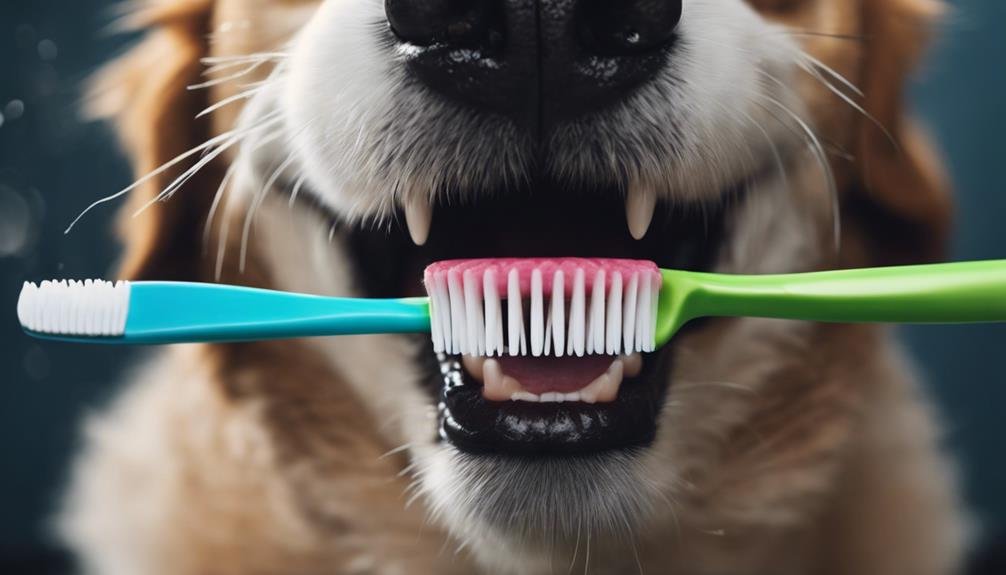
When brushing your dog's teeth, it is crucial to pay close attention to the gum line to prevent bacteria growth and maintain optimal oral health. Ensuring that you give proper care to this area can help prevent gum disease and other dental issues.
Here are some tips to help you focus on the gum line effectively:
- Angle the Brush: Hold the toothbrush at a 45-degree angle to reach the area where the teeth meet the gums.
- Gentle Pressure: Apply gentle pressure while brushing to avoid causing discomfort or irritation.
- Circular Motions: Use small circular motions along the gum line to thoroughly clean and massage the area.
- Regular Inspection: Take a moment to inspect the gum line for any signs of inflammation or bleeding during brushing sessions.
Gentle Brushing to Prevent Irritation
What gentle brushing techniques can be implemented to prevent irritation while maintaining your dog's oral hygiene? To ensure effective cleaning without causing discomfort, gentle brushing techniques are crucial. By using soft strokes and the right pressure, you can prevent irritation while still maintaining your dog's oral health. Below is a table illustrating some gentle brushing techniques to help you protect your furry friend's teeth and gums:
| Gentle Brushing Techniques | Description | Benefits |
|---|---|---|
| Use a Soft-Bristled Brush | Minimizes irritation to gums | Gentle cleaning for sensitive mouths |
| Circular Motions | Helps remove plaque efficiently | Ensures thorough cleaning |
| Light Pressure | Prevents gum damage | Maintains oral hygiene |
Gradual Acclimation to Brushing
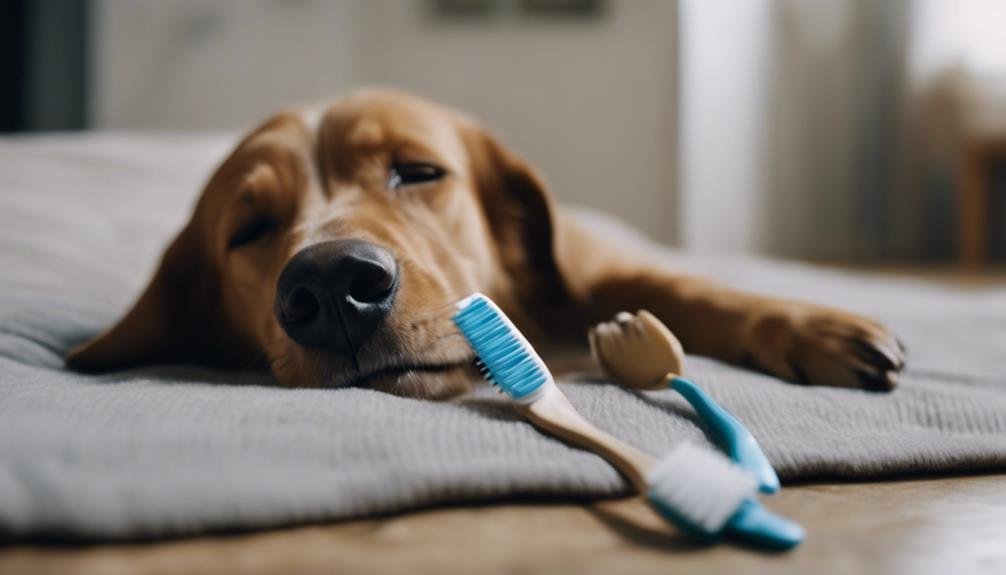
To ensure a smooth and comfortable transition into establishing a regular brushing routine for your dog, gradually acclimating them to the process is key. Here are some tips to help you acclimate your dog to teeth brushing:
- Start Slow: Begin by gently touching your dog's mouth and teeth to get them used to the sensation.
- Short Sessions: Keep the initial brushing sessions short to prevent overwhelming your dog.
- Positive Reinforcement: Reward your dog with treats or praise after each brushing session to create a positive association.
- Increase Frequency: Gradually increase the frequency of brushing sessions as your dog becomes more comfortable.
Conclusion
In conclusion, proper dental hygiene for your dog is essential for their overall health and well-being. By following the tips provided by a veterinarian on how to effectively brush your dog's teeth at home, you can prevent serious diseases, save on potential vet bills, and strengthen the bond with your furry companion.
Establishing a regular dental care routine will promote optimal oral health for your dog and contribute to their longevity.




